[Editor’s Note: Mad Scientist Laboratory welcomes back returning guest bloggers Colonel Montgomery Erfourth and Dr. Aaron Bazin, with another assessment of our adversaries’ capabilities in the near term — focusing today on the Islamic Republic of Iran. Their submission “identifies and assesses emerging technology and its malign use by Iran during the 2020-2027 timeframe through the lens of the National Security Strategy and the Special Operations mission. The assessment offers strategists and planners recommendations for how best to mitigate and address Iran’s anticipated use of emerging technology against U.S. national interests.” Enjoy!]
Introduction
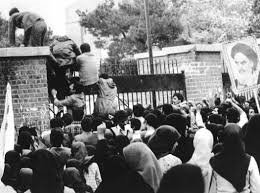 The U.S. and the Islamic Republic of Iran have had a contentious relationship throughout the past decades. Heightened moments of tension in the past include the 1979 Iran hostage crisis1, the Iran-Iraq war2, continued disagreements over Iran’s nuclear ambitions3, and, most recently, the 2020 killing of General Soleimani, Commander of the Iranian Qods Force.4 The National Security Strategy 2017
The U.S. and the Islamic Republic of Iran have had a contentious relationship throughout the past decades. Heightened moments of tension in the past include the 1979 Iran hostage crisis1, the Iran-Iraq war2, continued disagreements over Iran’s nuclear ambitions3, and, most recently, the 2020 killing of General Soleimani, Commander of the Iranian Qods Force.4 The National Security Strategy 2017 identifies Iran as a destabilizer in the Middle East and calls for the deterrence and disruption of Iranian-backed terrorist organizations. Additionally, it elevates disrupting Iranian nuclear ambitions to a priority action for the United States.5
identifies Iran as a destabilizer in the Middle East and calls for the deterrence and disruption of Iranian-backed terrorist organizations. Additionally, it elevates disrupting Iranian nuclear ambitions to a priority action for the United States.5
Following the Iran-Iraq war, Iran cultivated relationships across the region to extend its reach, further its interests, and bolster its asymmetric strength.6 These relationships have many labels: proxy, surrogate, clients, and partners.7 None of these labels accurately represents the many entities in its network. For this post, Iran’s network is a constellation of regional relationships used to extend its military and political reach while mitigating the political costs of its foreign activities. While this post explores the future use of emerging technology by Iran, it also explores how Iran might share these technologies with other actors in its constellation.
The reader needs to keep in mind that Iranian military doctrine and military action are primarily defensive and asymmetric.8 Due to sanctions and its isolated status in the international community, Iran is unable to acquire what it needs to be the dominant actor in the region. To compensate for this, it seeks out hybrid warfare capabilities and uses a network of proxy organizations to further Iranian interests.9
The post consists of three sections. The first examines Iran’s existing conventional weapons and military technology capabilities. The second section identifies the emerging technologies that will pose the greatest threat to U.S. national security in the 2020-2027 timeframe, projects their anticipated use, and provides targeted recommendations to enable the Special Operations Forces (SOF) community to address each challenge. The third section highlights strategic recommendations to ensure that the community is prepared to counter the broader Iranian threat.
1. Conventional Weapons: State of Affairs and Projected Developments
Iran maintains conventional weapons capabilities and military technology that pose a threat to U.S. national security interests and the freedom of maneuver of U.S. military forces in the region. The following discussion details the current state of these capabilities and their projected developments in the near-term future.
Nuclear Program
In 2015, the Iranian and U.S. governments signed the Joint Comprehensive Plan of Action (JCPOA)10, which limited Iran’s “breakout time to a nuclear weapon from an estimated few months to one year or more.”11 Iran then reduced its nuclear stockpile below the capacity threshold needed to make one nuclear bomb. However, in January 2020, Iran’s Foreign Minister Mohammad Javad Zarif officially suspended all limits imposed on Iran’s ability to enrich uranium, reversing this reduction.12 The graphic below illustrates the increase in Iran’s enriched uranium stockpile.13

The current estimated timeline of their ability to produce a nuclear weapon is four months.14 With the JCPOA agreement effectively dissolved, Iran’s threat to pursue atomic weapons reemerged as a strategic bargaining tool.15 Given the sanctions placed against the country, the authors expect Iran to leverage the potential growth of its stockpile capacity as a means to return to the negotiating table and reduce economic sanctions.
Ballistic Missiles

Iran continues to develop its ballistic missile capability as a crucial part of its military arsenal.16 Their intercontinental ballistic missile programs “pose a conventional military threat to regional stability” because of their ability to carry nuclear payloads, should Iran acquire the technology.17 The January 2020 Iranian missile attack on Ain al-Asad airbase demonstrated their improving target precision.18 In the next seven years, the proliferation and accuracy of Iranian missiles will further contribute to a degraded anti-access / area denial operating environment for the U.S. Navy and U.S. bases in the region.
Anti-Ship Capabilities and Fast Attack Crafts
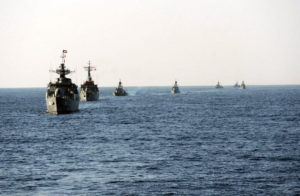
In 2015, Iran conducted a wargame* on a fake aircraft carrier, focused on naval attack and maneuver. They may repeat this exercise in 2020, focusing on cruise missile precision.19 Iran also has anti-ship missiles they can deploy from land, air, and sea – namely, the Noor anti-ship cruise missile with a range of 75 miles / 120 kilometers.20 As discussed above, Iranian ballistic missiles boast a notable degree of accuracy. Therefore, this post anticipates anti-ship missiles will become an increasing threat to U.S. naval assets operating in the Arabian Gulf.
Iran has engaged in hostile small boat maneuvers against U.S. aircraft carriers in the Gulf.21 These small boat attacks employing fast attack crafts have used swarm-like tactics to surround aircraft carriers with asymmetric maneuvers that are not traditional in conventional naval warfare.22 While this hostile activity has not yet resulted in an attack on a U.S. aircraft carrier, the types of Iranian boats used and their capabilities are cause for concern. Fast attack boats that can deploy missiles and torpedoes will remain a high threat to U.S. naval operations in the region.
‘Midget’ Littoral Submarines
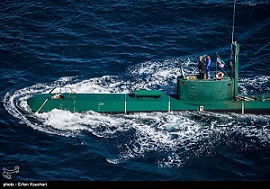
Iran’s missile capability is also credible underwater. Last year, Iran “launched a cruise missile from a submarine for the first time during an ongoing annual military drill in the Strait of Hormuz.”23 The types of midget or littoral submarines vary, and apart from the Iranian-made Ghadir class, their subs come from different nations such as North Korea (Yugo class) and Russia (Kilo-class). With the ability to carry anti-ship cruise missiles, these littoral submarines contribute to Iran’s anti-access / area-denial strategies in the Gulf.24 Given the strategic benefits to Iran, it is highly likely that it will continue to broaden the capabilities of its submarines and look to purchase more.
The next section examines anticipated developments in the emerging technology space that enable unconventional warfighting. It explores new technologies that Iran currently uses, or may use, against U.S. national security interests.
2. Anticipated Emerging Technology Developments
Iran’s military strength lies in its asymmetric use of technology and its relationships. To further its interests, Iran will continue the trend of using asymmetric technology itself as well as transferring this technology to actors in its constellation of relationships in the next decade. The technologies below have the most asymmetric promise to deliver effects that would be opposed to U.S. activities and interests.
Cyber Offensive Actions
Nation-state actors, such as Iran, and asymmetric non-state actors, such as those within its constellation of relationships in the Middle East, can compromise U.S. internal security from remote positions. These types of challenges are now possible because of America’s economic dependency on digital infrastructure; this very infrastructure is vulnerable to cyber-attacks.
Iran has a substantial cyber offensive capability, which it has leveraged to conduct attacks. Iran has compromised the security of U.S. banks, forced the Atlanta municipal government to take government operations offline for a week, and led  attacks on people associated with the last election’s U.S. presidential campaign.25 It also targeted military infrastructure and penetrated the U.S. Navy’s unclassified network.26 One can anticipate that Iran will continue to develop its cyber capabilities, as well as electronic warfare capabilities, and will continue to employ them against U.S. critical infrastructure in addition to military targets. It is highly likely that Iran will further its cyber intelligence, surveillance, and reconnaissance (ISR) capabilities and transfer this technology to other entities in its constellation of relationships across the region.
attacks on people associated with the last election’s U.S. presidential campaign.25 It also targeted military infrastructure and penetrated the U.S. Navy’s unclassified network.26 One can anticipate that Iran will continue to develop its cyber capabilities, as well as electronic warfare capabilities, and will continue to employ them against U.S. critical infrastructure in addition to military targets. It is highly likely that Iran will further its cyber intelligence, surveillance, and reconnaissance (ISR) capabilities and transfer this technology to other entities in its constellation of relationships across the region.
To mitigate Iran’s increased ISR capabilities, SOF operators will need to make more significant efforts to mask, control, and obfuscate signatures emitted by their devices. SOF Acquisitions, Technology, and Logistics (AT&L) should seek to understand the emerging electromagnetic and cyber environments in which SOF will be operating and assess how operators can manage the signatures of their devices.
Artificial Intelligence (AI) and Robotics
AI serves as a force multiplier when it converges with other technologies. The following examines the consequences of the convergence of AI with robotics, specifically unmanned aerial vehicles (UAVs), unmanned underwater vehicles (UUVs), and sea mines.
• Unmanned Aerial Vehicles (UAV)
Over the past years, Iran has leveraged military drones against U.S. forces in the Arabian Gulf, has jammed27 and shot down28 U.S. military drones, and is assumed to have shared military drone technology with entities in the region29 that are part of its constellation of relationships. It is highly likely that Iran will seek to build on its existing UAV technology and develop tactical military swarms. Swarms could use Commercial-Off-The-Shelf (COTS)  technologies paired with expertise in AI and swarming algorithms. This capability, along with continued UAV proliferation, would provide Iran the ability to target with short notice while avoiding detection. Iran could use this in theater operations, against U.S. outposts in the region, and in dense urban environments where U.S. operators conduct missions. The SOF community should explore anti-swarm capabilities that are size-appropriate for operators and capability-appropriate for UAV technologies in the region.
technologies paired with expertise in AI and swarming algorithms. This capability, along with continued UAV proliferation, would provide Iran the ability to target with short notice while avoiding detection. Iran could use this in theater operations, against U.S. outposts in the region, and in dense urban environments where U.S. operators conduct missions. The SOF community should explore anti-swarm capabilities that are size-appropriate for operators and capability-appropriate for UAV technologies in the region.
• Unmanned Underwater Vehicles (UUV)
Similar to UAVs, technological advancement with UUVs continues. Just as Iran leverages UAVs in the air to monitor U.S. ships in the Arabian Gulf region30, it is highly likely Iran will seek effective ways to monitor U.S. activity underwater. It would be in Iran’s interest to commission a fleet of UUVs to conduct Mine Countermeasure (MCM)31 — like operations for non-countermine purposes. For example, to map out (e.g., Search, Classify, Map [SCM]) U.S. Naval assets, as well as to leverage the second phase in MCM (Reacquire, Identify, Neutralize [RIN]32) to apply force against U.S. Naval assets. Should Iran seek to leverage UUVs for this purpose, it may compromise special operations covert missions. Specifically, ‘smart’ UUVs equipped with sensors and algorithms may be able to compromise operator missions that use shallow water combat submersible and dry combat submersible systems.33 The authors recommend the SOF community conduct anticipatory research on UUV technology and sensors that could compromise existing watercraft systems used by operators.
• Sea Mines
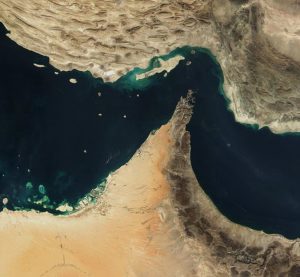
Iran’s use of sea mines challenges U.S. military forces operating in the Arabian Gulf.34 Sea mines are not just operational impediments but also act as strong psychological deterrents. Iran may seek to leverage AI to assess the optimum placement of sea mines for maximum damage to adversary ships and minimum loss to commercial vessels. AI can use data such as sea-lane traffic, sea fleet capability of opposing forces, and the map of the seaway to simulate scenarios that derive the optimum layout of sea mines. If Iran were to use AI to optimize sea mine layout, it would mark a new generation of sea mine warfare35 that the SOF community should use to maintain situational awareness.
Additive Manufacturing & Indigenous Production
The ability to print objects by adding layer upon layer of a wide variety of materials has heralded a new era of manufacturing — “additive manufacturing,” also known as 3D printing.36 This technology offers asymmetric actors a tremendous advantage because it allows state and non-state actors to bypass legitimate pathways to advanced conventional arms by custom creating and rapidly prototyping new weapons.

In essence, 3D printing means that one can use a digitally designed file to take an idea and represent it in physical form. This technology allows Iran to transmit data by email across its constellation of entities to deliver unique capabilities faster and more efficiently. Additionally, these files are editable, enabling Iran to improve them over time. If Iran creates a capability, it can instantaneously transmit and leverage it in other geographical areas.
Additive manufacturing creates an asymmetric paradigm shift for weapons acquisition and production. The SOF enterprise should anticipate greater capabilities — not just from Iran, but also across the Iranian constellation of relationships in the region. To this end, SOF should further familiarize themselves with COTS additive manufacturing technologies that Iran could use for this purpose.
Cryptocurrency
 In 2018, the Iranian government declared its interest in using cryptocurrency to “support international trade outside of the traditional banking system” and as a means to bypass sanctions imposed against them.37 The following year, Iran held talks with representatives “from Switzerland, South Africa, France, England, Russia, Austria, Germany, and Bosnia” to discuss cryptocurrency use at a national level.38 While nation-states must comply with regulatory norms to implement cryptocurrency, this alternative form of currency serves as a bona fide substitute to the existing international financial system. Iran’s declared intent to use this technology suggests it is either using or is planning to use this technology with actors in its regional constellation of relationships.
In 2018, the Iranian government declared its interest in using cryptocurrency to “support international trade outside of the traditional banking system” and as a means to bypass sanctions imposed against them.37 The following year, Iran held talks with representatives “from Switzerland, South Africa, France, England, Russia, Austria, Germany, and Bosnia” to discuss cryptocurrency use at a national level.38 While nation-states must comply with regulatory norms to implement cryptocurrency, this alternative form of currency serves as a bona fide substitute to the existing international financial system. Iran’s declared intent to use this technology suggests it is either using or is planning to use this technology with actors in its regional constellation of relationships.
This post asserts there is a high probability Iran will leverage cryptocurrency to provide financial support for the entities in its constellation. As actors exchange cryptocurrencies in the digital world, this technology offers Iran an alternative means to provide financial assistance to other entities outside the region. The SOF community should anticipate that Violent Extremist Organizations (VEOs) in the area would have access to and use cryptocurrencies. Here, the SOF community could also create a collaborative cryptocurrency working group to gather intelligence on the cryptocurrency movement.
The technologies highlighted above do not represent a comprehensive list of all emerging technologies Iran may seek to leverage or employ. Instead, it represents those that will significantly enhance Iran’s capability to pursue military objectives in the 2020-2027 timeframe to the detriment of U.S. national security.
3. Strategic Opportunities & Recommendations
Along with the many challenges Iran may pose, there are also many opportunities for the U.S. and its SOF on the horizon. These opportunities fall not just into technological areas. This section expands on recommendations that are strategic but do not relate to one particular technology.
Constellations of Relationships
Iran has cultivated its regional constellation of relationships with strategic patience and sophisticated curation. While the relationships with these entities do not  equate to assured loyalty, dependence, or obedience, Iran could use them to project power in critical areas in the Middle East. The authors see the creation of this constellation of relationships as a means to further political and military interests — a trend that other nation-states will seek to emulate. This model allows actors to compete on asymmetric terms below the threshold of war while creating a political standoff distance.
equate to assured loyalty, dependence, or obedience, Iran could use them to project power in critical areas in the Middle East. The authors see the creation of this constellation of relationships as a means to further political and military interests — a trend that other nation-states will seek to emulate. This model allows actors to compete on asymmetric terms below the threshold of war while creating a political standoff distance.
In this regard, the SOF community should revisit its VEO and Irregular Warfare strategies to assess how SOF should mitigate the threat posed by terrorist organizations that are part of a nation-state constellation. This strategy should differentiate VEOs that act unilaterally from those that interact with nation-states. This aspect will be of particular urgency as armed militias (across the VEO spectrum) start to modernize their equipment and tactics to include high-tech capabilities in their offensives.39
Cyber Effects & Weapons of Mass Destruction (WMD)
Smart infrastructure increases the cyber threat landscape. While one can expect Iran to be a rational actor and refrain from launching a crippling cyber-attack against the U.S. to avoid commensurate retaliation, this restraint may not be the case for organizations within its constellation of influence.
While nuclear weapons were a strong deterrent in the 20th Century and remain essential, U.S. dependence on the internet and digital infrastructure mean Iran can use the threat of cyber-attacks as a deterrent.  While deterrence of any kind is hard to measure, former U.S. Government officials expressed alarm regarding Iran’s investment in cyber capability as recently as January 2020.40 The SOF community should assess the degree to which cyber offensive actions and capabilities deliver similar effects as WMD and determine how it should use SOF to mitigate this risk within its Counter-WMD (C-WMD) authorities.
While deterrence of any kind is hard to measure, former U.S. Government officials expressed alarm regarding Iran’s investment in cyber capability as recently as January 2020.40 The SOF community should assess the degree to which cyber offensive actions and capabilities deliver similar effects as WMD and determine how it should use SOF to mitigate this risk within its Counter-WMD (C-WMD) authorities.
Resolution 2231: New Technology Acquisition
The United Nations Security Council (UNSC) Resolution 223141 “implements the 2015 nuclear agreement with Iran and imposes missile and arms-related restrictions.”42 During this period, Iran could only receive advanced conventional arms, related components, and services on a case-by-case basis with approval. However, the UNSC will lift this ban on October 18, 2020.43 It is highly likely Iran will seek to purchase advanced conventional weapons across all domains. The arms purchases will update Iran’s existing portfolio and demonstrate an enhanced military capability to its neighbors in the region. Within its responsibility for C-WMD, the SOF community should assess the WMD threat posed by the new technologies that Iran could acquire once the embargo lifts.
Conclusion
Overall, U.S. policymakers and the SOF community are justifiably concerned about Iran’s ability to innovate. Iran’s conventional ballistic missiles and asymmetric use of fast attack boats give them a competitive advantage in the Gulf region. At the same time, their new enrichment of uranium will most likely become a bargaining point in discussions on their nuclear program. Although anti-access / area denial is a crucial component to Iran’s defensive posture, it is clear that Iran may also seek to acquire game-changing technologies to challenge the U.S.
Emerging technologies and their convergence in the 2020-2027 timeframe will likely give Iran new tools to leverage in asymmetric ways. Iranian cyber  capabilities will serve as a useful asymmetric tool to escalate a conflict, and the convergence of AI and robotics will allow Iran to experiment with new unmanned capabilities across domains. Additive manufacturing will speed up indigenous production and the proliferation of technology to its constellation of relationships. Finally, cryptocurrencies could allow Iran to fund its interests in the region outside the international financial system.
capabilities will serve as a useful asymmetric tool to escalate a conflict, and the convergence of AI and robotics will allow Iran to experiment with new unmanned capabilities across domains. Additive manufacturing will speed up indigenous production and the proliferation of technology to its constellation of relationships. Finally, cryptocurrencies could allow Iran to fund its interests in the region outside the international financial system.
The many fractures in the U.S.–Iran relationship did not emerge overnight. It is safe to assume Iran will remain a prominent and capable actor in the Gulf region for many decades to come. The proliferation of technology and expertise represents a real and persistent concern. Simply put, to safeguard and advance U.S. interests, the SOF community must keep a close eye on Iran and create new options as new challenges arise, both today and into the foreseeable future.
If you enjoyed this post, check out our other posts by today’s authors:
Extremism on the Horizon: The Challenges of VEO Innovation
 >>> REMINDER 1: Mad Scientist Initiative is facilitating the third webinar in our series of on-line Weaponized Information events, next Wednesday, 3 June 2020 (1400-1500 EDT) on:
>>> REMINDER 1: Mad Scientist Initiative is facilitating the third webinar in our series of on-line Weaponized Information events, next Wednesday, 3 June 2020 (1400-1500 EDT) on:
-
- AI and Manufacturing Reality with Dr. Marek Posard and Dr. Christopher Paul, The RAND Corporation
In order to participate in this virtual event, you must first register here [via a non-DoD network]. Registration is limited, so sign up now! And stay tuned to the Mad Scientist Laboratory for more information on our upcoming Weaponized Information virtual events — we will open registrations one week prior to each event!
>> REMINDER 2: If you missed the first two webinars in our Mad Scientist Weaponized Information Virtual Events series — no worries! You can watch them again here and here [via a non-DoD network].
>> REMINDER 3: Mad Scientist wants your Information Warfare Vignettes! We launched this crowdsourcing exercise to complement our aforementioned Weaponized Information Virtual Events and we want to hear from you! Review submission guidelines on our flyer here, then craft and submit your most innovative and insightful visions of information warfare to us at: MADSCITRADOC@gmail.com. The winner of our writing contest will be present at our virtual conference on 21 July 2020 (stay tuned to the Mad Scientist Laboratory for further information on this event!). Deadline for submission is 1 July 2020!
About the Authors:
Colonel Montgomery Erfourth is currently the Integration Division Chief with the J5 at U.S. Special Operations Command in Tampa, Florida. He has over 25 years of professional military and civilian experience in the areas of leadership, planning, strategy, research, transportation, supply chain management, marketing, budget, and financial management. Monte has worked closely with U.S. Ambassadors, highest level of military leadership, and policy makers and performed duties in over 25 countries, several of which were in non-permissive environments.
Dr. Aaron Bazin adds value to organizations by helping them explore the possibilities of the future and develop unique, visionary strategies. He is a skilled researcher, facilitator, presenter, and writer. Aaron is currently the Managing Director of the Donovan Strategy and Innovation Group, U.S. Special Operations Command in Tampa, Florida. His team acts as catalyst for change and innovation across the Joint SOF enterprise to improve its ability to further national interests globally.
Disclaimer: The views expressed in this blog post are solely those of the authors and do not necessarily reflect those of the Department of Defense, U.S. Special Operations Command, Department of the Army, Army Futures Command, or the Training and Doctrine Command.
References
* The Great Prophet IX was an Iranian exercise in the area of the Strait of Hormuz on Larak Island in the Arabian Gulf. It was notable for using a full-scale mock-up of an American aircraft carrier as a target.
https://thediplomat.com/2015/02/in-a2ad-showcase-iranian-navy-sinks-nimitz-carrier-mock-up/
1 History. (2019). Iran Hostage Crisis. Middle East. https://www.history.com/topics/middle-east/iran-hostage-crisis
2 Riedel, Bruce. (2013). Lessons from America’s First War with Iran. Brookings Institute. https://www.brookings.edu/articles/lessons-from-americas-first-war-with-iran/
3 Sanger, David., Broad, William. (2020). Iran Challenges Trump, Announcing End of Nuclear Restrictions. New York Times. https://www.nytimes.com/2020/01/05/world/middleeast/trump-iran-nuclear-agreement.html
4 White House. (2020). Remarks by President Trump on the Killing of Qasem Soleimani. National Security and Defense. White House. https://www.whitehouse.gov/briefings-statements/remarks-president-trump-killing-qasem-soleimani/
5 White House. (2017). National Security Strategy of the United States of America. December 2017. White House. https://www.whitehouse.gov/wp-content/uploads/2017/12/NSS-Final-12-18-2017-0905.pdf
6 Ostovar, Afshon. (2018). The Grand Strategy of Militant Clients: Iran’s Way of War. Security Studies. VOL. 28., NO 1, 159-188. Taylor and Francis. https://doi.org/10.1080/09636412.2018.1508862
7 VICE. (2020). Iran’s power over Iraq. VICE on HBO. https://www.youtube.com/watch?v=oTPKJtPWNRQ
8 Connell, Michael. (2020). Iran’s Military Doctrine. United States Institute of Peace. https://iranprimer.usip.org/resource/irans-military-doctrine
9 Tabatabai, Ariane. (2019). Iran’s National Security Debate: Implications for Future US-Iran Negotiations. RAND Corporation. https://www.rand.org/content/dam/rand/pubs/perspectives/PE300/PE344/RAND_PE344.pdf
10 JCPOA. (2015). Joint Comprehensive Plan of Action. NTI. https://media.nti.org/pdfs/iran_deal_text.pdf
11 Sanger, David., Michael Gordon, (2015). “Deal Reached on Iran Nuclear Program; Limits on Fuel Would Lessen with Time,” The New York Times. https://www.nytimes.com/2015/07/15/world/middleeast/iran-nuclear-deal-is-reached-after-long-negotiations.html
12 NPR. (2020). Iran’s Foreign Minister: U.S. Strike On Soleimani An Act Of Terrorism And War. https://www.npr.org/2020/01/07/794150712/irans-foreign-minister-u-s-strike-on-soleimani-an-act-of-terrorism-and-war
13 Sanger, David., Broad, William. (2020). Iran Crosses a Key Threshold: It Again Has Sufficient Fuel for a Bomb New York Times. https://www.nytimes.com/2020/03/03/world/middleeast/iran-nuclear-weapon-trump.html
14 MacKenzie, Debora. (2020). It would take Iran more than 4 months to develop nuclear weapons. Physics – Analysis. New Scientist. https://www.newscientist.com/article/mg24532643-600-it-would-take-iran-more-than-4-months-to-develop-nuclear-weapons/
15 Elnhorn, Robert., Nepher, Richard. (2019). Constraining Iran’s future nuclear capabilities.Security, Strategy and Order Report. Brookings Institute. https://www.brookings.edu/wp-content/uploads/2019/03/FP_20190321_nuclear_capabilities_WEB.pdf
16 BBC. (2020). Iran attack: How strong is Iran’s military?. World. BBC News. https://www.bbc.com/news/world-middle-east-50982743
17 Einhorn, Robert., Van Diepen, Vann H. (2019). Report: Constraining Iran’s missile capabilities. Security Strategy and Order. Brookings. https://www.brookings.edu/wp-content/uploads/2019/03/FP_20190321_missile_program_WEB.pdf
18 The Economist. (2020). Iran’s attack on Iraq shows how precise missiles have become. Science and Technology. The Economist. https://www.economist.com/science-and-technology/2020/01/16/irans-attack-on-iraq-shows-how-precise-missiles-have-become
19 Tucker, Patrick. (2020). Iran Is Getting Ready to Blow Up A Fake Aircraft Carrier, Again. Defense One. https://www.defenseone.com/technology/2020/01/iran-getting-ready-destroy-its-fake-aircraft-carrier-again/162305/
20 Global Security. (2020). C-802 Noor / Nur – Anti-ship Cruise Missile. Iran Weapons – Cruise Missiles. https://www.globalsecurity.org/military/world/iran/noor.htm
21 U.S. Defense News. (2019). U.S. Navy Warships ‘Harassed’ by 20 Iranian Small Craft. https://www.youtube.com/watch?v=eua68dBvJCI
22 Rezaie, Reza. (2015). IRAN IRGCN asymmetric military power-missile boat fast attack swarm tactics. https://www.youtube.com/watch?v=CkbS4BQxTgg&feature=youtu.be
23 Karimi, Nasser. (2019). Tehran: Iran launches cruise missile from sub during drill. Military Times. https://www.militarytimes.com/flashpoints/2019/02/24/iran-launches-cruise-missile-from-submarine-during-drill/
24 Episkopos, Mark. (2019). Behold: Iran’s Mini-Submarine Force Is Dangerous (Partly Thanks to North Korea) . National Interest. https://nationalinterest.org/blog/buzz/behold-irans-mini-submarine-force-dangerous-partly-thanks-north-korea-59562
25 Hanna, Andrew. (2020). The Invisible U.S. – Iran Cyber War. The Iran Primer. United States Institute of Peace. https://iranprimer.usip.org/blog/2019/oct/25/invisible-us-iran-cyber-war
26 Barnes, Julian., Gorman, Siobhan. (2013). U.S. Says Iran Hacked Navy Computers. The Wall Street Journal. https://www.wsj.com/articles/us-says-iran-hacked-navy-computers-1380314771?tesla=y
27 Schwartz, Matthew. (2011). Iran Hacked GPS Signals To Capture U.S. Drone. Dark Reading. Information Week. https://www.darkreading.com/attacks-and-breaches/iran-hacked-gps-signals-to-capture-us-drone/d/d-id/1101882
28 Newman, Lily. (2019). The Drone Iran Shot Down Was a $220M Surveillance Monster. Wired. https://www.wired.com/story/iran-global-hawk-drone-surveillance/
29 Brookes, Peter. (2020). Is Iran Giving the Houthis Plane-Killer Missiles? National Interest. https://nationalinterest.org/blog/buzz/iran-giving-houthis-plane-killer-missiles-127392
30 Taylor, Adam. (2019). Drones watch every US ship in the Gulf, Iran navy chief claims. Stars and Stripes. https://www.stripes.com/news/middle-east/drones-watch-every-us-ship-in-the-gulf-iran-navy-chief-claims-1.591500
31 U.S. Navy. (2020). Mine Countermeasures Ships. U.S. Navy. https://www.navy.mil/navydata/fact_display.asp?cid=4200&tid=1900&ct=4
33 Tadjdeh, Yasmin. (2019). SPECIAL REPORT: New Special Operations Undersea, Surface Vehicles on the Horizon. National Defense Magazine. https://www.nationaldefensemagazine.org/articles/2019/5/14/special-report-new-special-operations-undersea-surface-vehicles-on-the-horizon
34 Woody, Christopher. (2018). The US Navy faces ‘a huge liability’ in countering one of Iran’s favorite and most dangerous weapons. Business Insider. https://www.businessinsider.com/us-navy-faces-a-huge-liability-in-countering-irans-use-of-sea-mines-2018-8
35 Rabiroff, Jon. (2011). U.S. military enters new generation of sea mine warfare. Stars and Stripes. https://www.stripes.com/news/u-s-military-enters-new-generation-of-sea-mine-warfare-1.143170
36 AM. (2020). What is Additive Manufacturing? AM Basics. Additive Manufacturing. https://additivemanufacturing.com/basics/
37 Ratna, Tanvi. (2020). Iran Has a Bitcoin Strategy to Beat Trump. Foreign Policy. https://foreignpolicy.com/2020/01/24/iran-bitcoin-strategy-cryptocurrency-blockchain-sanctions/
38 Tehran Times. (2019). ‘Talks with 8 countries over using cryptocurrency in monetary transactions going on’. Economy. Tehran Times. https://www.tehrantimes.com/news/432400/Talks-with-8-countries-over-using-cryptocurrency-in-monetary
39 Warrell, Helen. (2020). Future of warfare: high-tech militias fight smoldering proxy wars. Aerospace and Defense. Financial Times. https://www.ft.com/content/ab49c39c-1c0c-11ea-81f0-0c253907d3e0
40 Martin, Rachel. (2020). Federal Authorities Warn of Iran’s Cyber Threat Capabilities. Morning Edition. NPR. https://www.npr.org/2020/01/09/794816793/federal-authorities-warn-of-irans-cyber-threat-capabilities
41 UNSC (2015). Resolution 2231 (2015) on Iran Nuclear Issue. United Nations Security Concil. https://www.un.org/securitycouncil/content/2231/background
42 Lincy, Valerie., Taleblu, Behnam Ben. (2017). Iran’s compliance with UNSCR 2231: Alleged Violations Must be Addressed. Iran Watch. Foundation for the Defense of Democracies. https://s3.us-east-2.amazonaws.com/defenddemocracy/uploads/documents/MEMO_WPONAC.pdf
43 SIPRI (2016). UN arms embargo on Iran. SIPRI Databases – Arms Embargoes. Stockholm International Peace Research Institute. https://www.sipri.org/databases/embargoes/un_arms_embargoes/iran

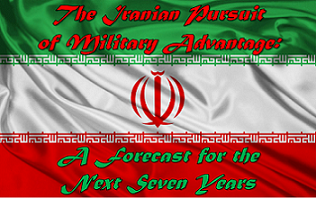


Great information! I wonder what sort of impact big data will have for Iran’s defensive operations and if there is an indication that a strategic information system will provide this in the near future?
In all fairness, the authors might have mentioned that it was the US withdrawal from the JCPOA (May 2018) which prompted the Iranian leadership to reconsider their approach toward nuclear weapon development. I suspect that the leaders in Iran believe that possession of a nuke may be the only argument to dissuade some in Washington from aggression.